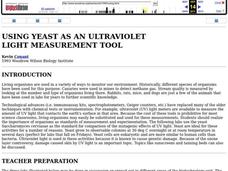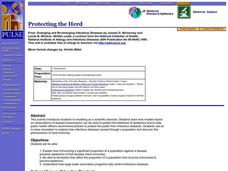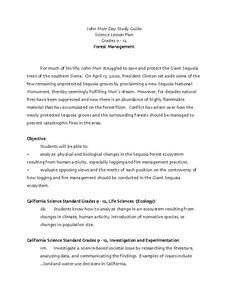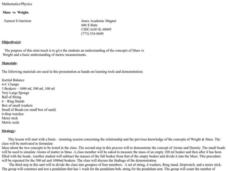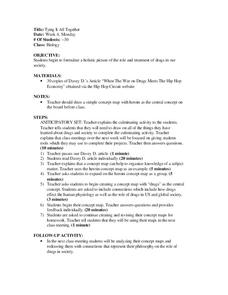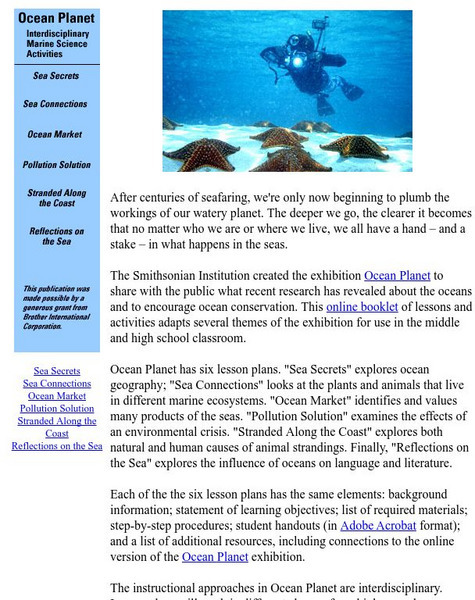Curated OER
Toxicology 2: Finding the Toxic Dose
Students brainstorm with group partners to decide upon a chemical they would like to test, and outline a procedure for their investigation. They then present in groups their ideas to the rest of the class as well as the chemical they...
Curated OER
Food Type And Calories Per Square Meter
Students compare the efficiency of producing food calories in different types of food then calculate how much land is required to supply their food for a year. They then graph the results.
Curated OER
Can Land Ethics Work?
Students evaluate the various purposes and issues surrounding the management of a nature preserve. They participate in discussion on whether there is intrinsic value in nature for its own sake.
Curated OER
The Genetic Basis of Neurological Disorders
Young scholars describe some aspects of known genetic defects on the human neurological condition. They participate in a variety of exercises including drawings, games, and analogies.
Curated OER
Using Yeast as an Ultraviolet Light Measurement Tool
Students accurately measure the relationship between radiation dose and either survival or some genetic event such as mutation or recombination. They investigate the damage that was done to the DNA molecule as a result of exposure to...
Curated OER
Protecting the Herd
Students explain how immunizing a significant proportion of a population against a disease prevents epidemics of the disease (herd immunity). They list factors that affect the proportion of a population that must be immunized to prevent...
Curated OER
Putting on Mass: Just how do Trees grow?
Students articulate an explanation of photosynthesis. They identify problems they have with comprehension of how a plant gains mass. Students describe a historical experiment.
Curated OER
Forest Management
Learners explore the changes in the Sequoia forest ecosystem. They evaluate reasons for the changes and discuss opposing views of human activity, logging and fire management practices. Students observe a video, describe the location of...
Curated OER
Field Experiments on Succession
Student develop a hypothesis regarding the effects of either mowing or fertilizer upon the diversity of plant species in a grassland ecosystem. They set up experiment field plots and measure species richness.
Curated OER
Inquiry and the Nature of Science
High schoolers identify questions that can be answered through scientific investigations, design and conduct a scientific investigation. They also use appropriate tools and techniques to gather, analyze, and interpret data.
Curated OER
Mass vs. Weight
Students make generalizations about weight and mass by engaging in two hands-on experiments. In this weight and mass lesson, students weigh both an empty beaker and beakers with various amounts of weight inside of them in order to find...
Curated OER
Making Good Decisions
Students practice the skill of reasoned decision making. In this making decisions lesson plan, students read from the website 'Little Planet Times' and use the 'Making Good Decisions' E-Sheet to help with the article. Students divide...
Curated OER
Primate Classification 2006
Learners examine groups of hierarchy and see how primates are categorized. In this primate classification lesson students view video and slides then examine the taxonomy of primates.
Curated OER
Addiction As A Disease
Students study drug addiction and its problem in society. In this addiction lesson students answer questions and complete an activity.
Curated OER
Tying it all Together
Students study an article on drugs in their society. For this investigative lesson students create their own concept map.
Other
Nrc: Unit 2 the Uses of Radiation
A lesson plan on the uses of radiation in science, industry, and medicine. Gives many household examples of how radiation is used. Students will also learn about the NRC's role in regulating radioactive materials.
Alabama Learning Exchange
Alex: Animal, Insect, and Bird Classification
As a follow-up to a unit on the classifications of animals, insects, and birds, students will attend a distance learning field trip. The students will then e-mail trusted adults some of the information learned about the classification of...
Louisiana Department of Education
Louisiana Doe: Louisiana Believes: English Language Arts, Grade 10: Henrietta's Dance
Students consider the importance of leaving a legacy and the myriad ways that we can leave a legacy, through our language, our families, or even our cells. Students also explore the issue of ownership and ethics of medical research. This...
Smithsonian Institution
Smithsonian: Ocean Planet: Interdisciplinary Marine Science Activities
Smithsonian Institution presents ?Ocean Planet: Interdisciplinary Marine Science Activities?. Through this series of six interdisciplinary lessons, students will look at such things as the organisms in different marine ecosystems, the...
Alabama Learning Exchange
Alex: Biodiversity: Local Ecosystem & Food Web
This is a hands on lesson in which students will explore their local community to identify living things. It can be used as part of a unit on biodiversity and energy transfer within a biology, zoology, or environmental science course, or...
University of Arizona
University of Arizona: Pulse: Striding Into the Future: Clinical Trials
An interdisciplinary unit teaching the topic of scientific research performed on human subjects for a skin cancer study. The physics principles behind imaging techniques, the biological implications of UV radiation on the skin, the...
Alabama Learning Exchange
Alex: Pass It Down
This lesson, Pass It Down, integrates science and math into two consecutive hands-on genetics activities that should be embedded within an existing genetics unit suitable for biology learners. The results of each activity will be...
Alabama Learning Exchange
Alex: The Circles of Life
This is an inquiry based cooperative learning unit that can be used in biology as a graduation exam review or in botany for a nine week project. The learners will learn the life cycle of mosses, ferns, gymnosperms and angiosperms. The...
Alabama Learning Exchange
Alex: Can You Curl Your Tongue?
This lesson is adapted from a Connected Mathematics Unit, How Likely is It? This investigation introduces biology as a source of applications for probability. In this lesson, Curling your Tongue, students determine how many students in...
Other popular searches
- Biology Unit Test
- Biology Unit Plans
- Plant Biology Unit Plans
- Biology Unit 1
- Biology Unit 3
- Biology Unit Cell
- Biology Unit 1 Review
- Biology Unit Classification
- Biology Unit Lesson Plan
- Biology Unit With Fiction
- Ib Biology Unit Plans
- Biology Unit (Ecology)






